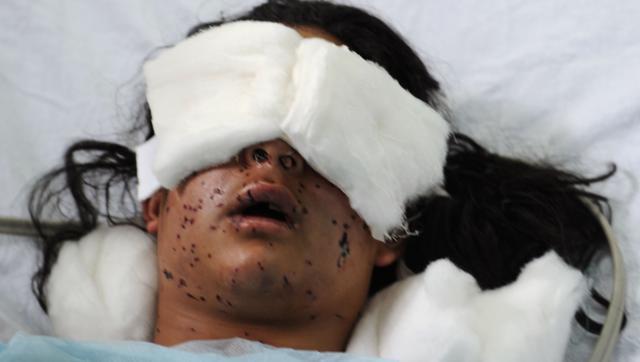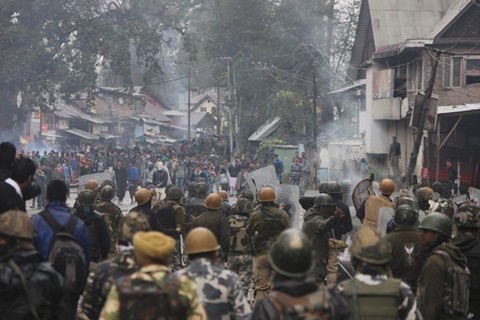Mum’s the Word: Even as a Teenager succumbs to Pellet Wounds in Kashmir, the Ordinance Factory at Khadki declined an RTI application seeking information on the safety of riot control methods

Image: AFP
Even as a pellet-riddled body of a teenager was found in Kashmir capital late last night, triggering massive clashes in Srinagar today, the Indian Ministry of Defence (MOD) remains adamant in not releasing information on the efficiency of riot control weapons used to control crowds and protest. Greater Kashmir reported that the body of Nasir Shafi aka Momin, son of Muhammad Shafi, a resident of New Theed Harwan in Srinagar, was found near Sarband water reservoir in the area late last night, said locals, alleging that he was chased by forces during clashes.
Meanwhile RTI activist Venkatesh Nayak, has through a detailed investigation uncovered the fact that the Indian Ordinance Factory, Khadki refuses access to information about the sale and efficacy of riot control weapons. In response to detailed queries under the Right to Information Act (RTI), the chief public information officer (CPIO) of Khadki Ordnance Factory has replied that none of the information sought in the RTI application may be disclosed as it is "sensitive defence information". How anti-riot weapons and ammunition, used internally, amount to "defence information" is perplexing to say the least.
Ordinance Factory, Khadki refuses access to information about the sale and efficacy of riot control weapons
Disturbed by the spiralling violence and the number of injuries and casualties reported all over Kashmir, Venkatesh Nayak sought some information from the Ordnance Factory Board (OFB) based in Kolkata, about the characteristics and specifications of anti-riot weapons, their sale price and quantum of sale since 2010 and evaluation reports about their efficacy and impact on human beings. The defence forces, paramilitary forces and State police organisations use several arms and ammunition manufactured at units operating under the control and supervision of the OFB. The paramilitary forces deployed in Kashmir are organisations notified as partially exempt from the coverage of the RTI Act, so there was no point in seeking information from them directly. As a rule they have refused access to information about their security-related activities in the past.
In July, 2016, Venkatesh Nayak sought the following information from the OFB:
"I would like to obtain the following information from your public authority under the RTI Act, 2005 relating to the manufacture and sale of anti-riot weapons and related ammunition:
1) A clear photocopy of all official records/documents that describe the physical characteristics and specifications of all weapons and related ammunition manufactured for the purpose of riot control by the Ordnance Factories under your jurisdiction along with the name and location of the factories where manufactured;
2) A clear photocopy of all official records/documents containing the wholesale price and maximum retail price fixed currently for all categories of anti-riot weapons and related ammunition manufactured by the Ordnance Factories under your jurisdiction;
3) A clear photocopy of all official records/ documents relating to the sale of the anti-riot weapon- “12 Bore Pump Action Gun” and related ammunition containing specific details such as the identity of the buyer, date of sale, sale price, and quantity of such guns and related ammunition sold. Please provide the said information for every transaction that took place from 01 January 2010, till date; and
4) A clear photocopy of all studies relating to the efficacy and impact of the anti-riot weapon- “12 Bore Pump Action Gun” and all types of cartridges usable with such gun “held by” your public authority or which is “under the control of” your public authority as understood in terms of Section 2(j) of the RTI Act."
The OFB circulated the RTI application to several desks and the responses trickled in (1st attachment). One desk pointed out that anti-riot weapons are not civilian trade items (see page 5). It also pointed out that 12 bore pump action shot guns are a civilian trade item being issued only to the State Bank of India for security purposes. Another desk pointed out that the anti-riot weapons are issued to State organisations, so the information sought may not be disclosed under RTI (see page 4). They also found that anti-riot weapons were primarily manufactured at the plant in Khadki, Pune and transferred the RTI application to the CPIO at Khadki. It is not clear whether the security forces used 12 Bore pump action shot guns in Kashmir. The Media reports that Nayak sifted through do not mention the exact specification of the gun used, the main discussion is about the nature of cartridges used. As this was the only type of pump action shot gun mentioned on the OFB's website, Nayak, then, made a specific mention of it in the RTI application.
Background
Readers are aware that Kashmir has been in turmoil since the end of Ramzan, in July 2016. Almost every day, violent protesters have clashed with security forces across several districts in the Kashmir valley. According to media reports, the use of pump action shotguns to fire pellet cartridges has resulted in serious injuries to people, including innocent bystanders. Medical specialists have been rushed from Delhi and other cities to treat the injured. Meanwhile, the security forces are reported to have told the Jammu and Kashmir High Court that 3,000 pellet bearing cartridges and 8,650 tear gas cannisters have been used to disperse the protesters between July-August. According to recent media reports, the death toll has gone up to 80. Ambulances carrying the injured also bore the brunt of the violence. Hundreds of security personnel are reported to have suffered serious injuries, while on duty.
Meanwhile, the authorities are discussing alternative methods of dealing with violent mobs to minimise injury. The CRPF, which is the main paramilitary force deployed for restoring public order in the valley, is reported to have told the J&K High Court that given the dynamic and mobile situation on the ground it would be difficult to follow standard operating procedures (SoPs) for crowd control issued by the Government. They are reported to have said that the use of pellet guns is an approved method according to the SoPs for crowd control. They have also claimed that if pellet guns are done away with, they will have to resort to firing bullets which may hike up the casualty figures. The SOPs for crowd control that the RTI activist, Nayak obtained in 2012 through The Right to Information Act, 2005 (RTI Act) do not contain any reference to pellet guns as an approved method of crowd control (2nd attachment). These SOPs were drawn up after the episode of violent protests in Kashmir in 2010. Perhaps there is another crowd control SOP with the CRPF which it has not disclosed in the public domain.
The CPIO of Khadki Ordnance Factory has replied that none of the information sought in the RTI application may be disclosed as it is "sensitive defence information". How anti-riot weapons and ammunition, used internally, amount to "defence information" is perplexing to say the least.

The applicant had not asked information about weapons and ammunition used to defend the country against external aggression. Nayak was only asking information about the specifications and characteristics, pricing and sales data about anti-riot weapons and copies of reports that indicate the efficacy of such weapons and their impact on human beings who are targeted. The queries were about weapons and ammunition used against citizens within the country. Even this information has been denied by invoking Section 8(1)(a) of the RTI Act without showing how India's 'security interests' would be prejudicially affected by such disclosure.
Even more puzzling is the denial of all information on the ground that it is in the nature of commercial confidence, trade secrets and intellectual property whose disclosure may result in harm to the competitive position of a third party. It is not clear which third party's interests the CPIO is trying to protect. I had sought information about anti-riot weapons manufactured and sold by the Khadki Ordnance Factory not by any other entity. So how the disclosure of data about prices, sales and physical characteristics about anti-riot weapons will be attracted by any of the exemptions under Section 8(1)(d) is a big mystery. The RTI application and the responses received are in the 1st attachment.
The OFB's website contains information about the characteristics and specifications of even defence equipment, let alone civilian trade items like revolvers and sporting rifles which their units manufacture. Specifications about mortars, 155mm guns, machine guns and the like are found on the OFB's website. Similarly there is considerable information about grenades and rocket bombs on the OFB's website. Strangely, there is more proactive disclosure about the specifications of defence equipment than anti-riot weapons and ammunition which are used against citizens within the country.
Further, the CPIO's argument that evaluation reports of anti-riot weapons cannot be disclosed on grounds of it being "sensitive defence information" related to commercial confidence, trade secrets and intellectual property is difficult to accept. In 2012, Venkatesh Nayak was able to obtain not only the SOPs for crowd control but also the reports of the committee set up in 2010 that evaluated the efficacy of various methods available for crowd control (see pages 28-40 in the 2nd attachment).
When the Government has already disclosed the exact number of pellet cartridges and tear gas shells used to quell the violent protests in Kashmir before the High Court, there is no reason why sale price, quantum of sale and efficacy reports cannot be shared with the people proactively. The SOPs cannot be misused by vested interests as they do not contain any information about the strategies used by the forces to control protesting mobs. Similarly, sales data cannot be misused in any manner as it is taxpayer funds that are being used to buy the equipment and ammunition. Given the large scale of serious injuries to people in J&K there is an overwhelming public interest in disclosing the evaluation reports of riot control weapons including pellet guns, says Venkatesh Nayak.
Nationwide criticism of misuse of pellet guns on innocent bystanders in Kashmir apart, the Modi regime appears keen on concealing all information regarding the use of pellet guns in Kashmir. This comes even as political commentators have begun discussing the hardline approach to ‘solving’ the Kashmir issue, suggested by National Security Adviser((NSA) Ajit Doval – and therefore it appears that Kashmir is heading for another crackdown. The Narendra Modi government has made it clear that it wants to take back control of the streets from stone-pelting youth. A security official told the Business Standard “Sooner or later, we will have to retake control in South Kashmir. The longer we wait, the more emboldened the protesters become, the more force will be required to deal with them”.